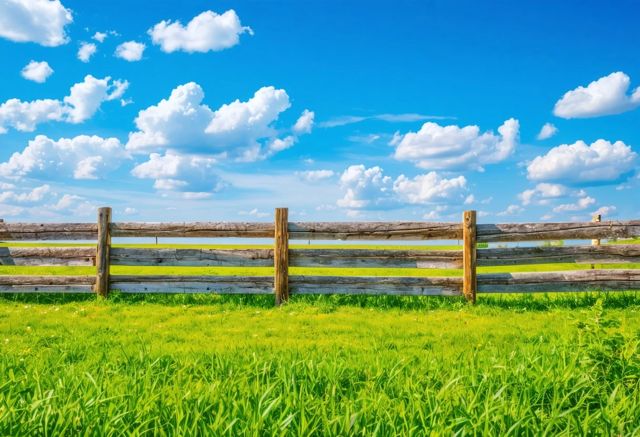Choosing the right wood fence involves considering your budget, climate, and insect resistance. Redwood, cedar, and cypress are ideal for wet climates, while pine and oak are better for dry areas but may require treatment for durability.
Understanding Different Types of Wood
This section covers the various types of wood that can be used for fencing, such as pine, cedar, redwood, and spruce. Each type of wood offers unique characteristics and benefits, making it important to choose based on factors like your budget, climate, and insect resistance.
Redwood
- Highly durable and naturally resistant to rot and insects.
- Ideal for wet climates like the Pacific Northwest.
- Beautiful reddish-brown color and lasts 20-25 years with minimal maintenance.
Pine
- Budget-friendly and easy to work with.
- Vulnerable to dents and warping; lasts 10-15 years.
- Requires treatment as it’s not naturally water-resistant.
Cedar
- Naturally resistant to rot and insects.
- Suitable for wet climates and can last up to 30 years.
- Available in Western red cedar and white cedar.
Cypress
- Similar durability to redwood and naturally insect-resistant.
- Good for windy, rainy, and humid regions.
Oak
- Very durable but not naturally insect-resistant.
- Best for dry climates unless treated.
Douglas Fir
- Exceptionally strong and has a long-lasting quality appearance.
- Fades to a gray hue unless sealed.
Pressure Treated Wood
- Affordable and pre-treated to resist rot and insects.
- Less stable than other woods but customizable with paint.
Factors to Consider
- Local Weather: Choose wood based on your climate.
- Budget: Higher cost usually means more durability and lower long-term costs.
- Insects: In regions with termites, choose wood with natural oils or get affordable wood treated.
Each type of wood offers different benefits tailored to various needs and regional conditions. Redwood, cedar, and cypress are excellent for wetter climates due to their natural resistance to rot and insects. Pine and oak work better in drier areas but may require treatment for durability. Pressure-treated wood is an economical choice for those on a tighter budget. Always weigh the initial cost against the wood’s longevity and maintenance needs to choose the best option for your fence.

Climate Considerations for Your Wood Fence
Different climates can significantly impact the performance of wood fences. Selecting the right type of wood based on your local weather conditions ensures longevity and durability.
In humid regions, moisture-resistant woods are essential. Cedar and cypress are excellent choices:
- Cedar: Naturally resists pests and rot, making it ideal for wet climates.
- Cypress: Offers similar benefits but can be more expensive due to shipping costs.
For areas with dry heat, choosing wood that can withstand intense sunlight and heat is crucial. Options include:
- Redwood: Known for its durability and aesthetic appeal.
- Southern Yellow Pine: Often pressure-treated to resist decay and can handle dry conditions well.
Cold climates demand woods that can endure freezing temperatures and moisture from snow:
- Spruce, Fir, and Pine: Durable and affordable options often treated to resist pests and rot.
- Cedar: Performs well in cold climates due to its natural resistance to decay.
Understanding your climate helps in making an informed decision about your wood fence, ensuring it stands strong against the elements.
Budgeting for Your Wood Fence Project
When planning for a wood fence project, understanding the costs involved is crucial. Here are key considerations to help you budget effectively:
Different wood types come with varying price tags:
- Cedar: Known for its durability and resistance to insects, cedar is a popular but pricier choice.
- Pine: Treated pine is more affordable but may require more maintenance over time.
- Redwood: Offers natural beauty and longevity but at a higher cost compared to other options.
Understanding Costs
- Redwood: approx. $48 per linear foot.
- Pine: approx. $28 per linear foot.
- Cedar: approx. $33 per linear foot.
- Cypress: typically $29 per linear foot.
- Oak: approx. $35 per linear foot.
- Douglas Fir: approx. $32 per linear foot.
- Pressure Treated Wood: $10-25 per linear foot.
Installation fees can also vary significantly. Factors influencing these costs include:
- Fence Size: Larger fences naturally require more materials and labor.
- Terrain: Uneven or rocky ground can increase labor costs.
- Customization: Features like gates, decorative elements, or unique designs can add to the price.
Maintenance expenses are another important consideration:
- Regular Staining/Sealing: To extend the life of your wood fence, regular maintenance is necessary.
- Repairs: Weather and wear can lead to repair costs over time, especially for wood types more prone to damage.
Investing in a quality wood fence can lead to long-term savings:
- Durability: Higher quality materials and proper maintenance mean fewer replacement and repair costs.
- Property Value: A well-maintained fence can enhance curb appeal and potentially increase property value.
By considering these factors, you can create a realistic budget for your wood fence project, ensuring both quality and cost-effectiveness.

Choosing a Style That Suits Your Property
When selecting a wood fence style, it’s essential to consider both your property’s aesthetic and your privacy needs. Different styles cater to various preferences and requirements. Here’s a breakdown of popular wood fence styles:
- Picket Fences: Ideal for enhancing the charm of traditional homes. These fences are also great for defining boundaries without obstructing views.
- Privacy Fences: Perfect for creating secluded spaces. These fences typically have closely spaced boards to ensure maximum privacy.
- Lattice Fences: Adds an elegant touch to your property while offering partial privacy. They are great for supporting climbing plants.
- Shadowbox Fences: Provide a balance between aesthetics and privacy. They feature alternating boards on each side of the fence, creating a visually appealing pattern.
Choosing the right style will depend on your property’s design, the level of privacy you desire, and any specific maintenance needs. For expert craftsmanship and tailored fencing solutions, trust our team to help you install the perfect wood fence for your home.

FAQ
What are the benefits of choosing redwood for a fence?
Redwood is highly durable and naturally resistant to rot and insects, making it ideal for wet climates. It has a beautiful reddish-brown color and can last 20-25 years with minimal maintenance.
Is pine a good material for fencing?
Pine is budget-friendly and easy to work with but is vulnerable to dents and warping. It lasts 10-15 years and requires treatment as it is not naturally water-resistant.
Why is cedar a popular choice for wood fences?
Cedar is naturally resistant to rot and insects, making it suitable for wet climates. It can last up to 30 years and comes in Western red cedar and white cedar varieties.
How does cypress compare to other wood options?
Cypress offers similar durability to redwood and is naturally insect-resistant. It is good for windy, rainy, and humid regions.
What should I know about using oak for my fence?
Oak is very durable but not naturally insect-resistant, making it best for dry climates unless treated.
Is Douglas Fir a good option for fencing?
Douglas Fir is strong and has a long-lasting quality appearance, though it fades to a gray hue unless sealed.
What are the advantages of pressure-treated wood?
Pressure-treated wood is affordable and pre-treated to resist rot and insects but is less stable than other woods. It is customizable with paint.
How does climate affect the choice of wood for fencing?
Different climates can significantly impact the performance of wood fences. Moisture-resistant woods like cedar and cypress are ideal for humid regions. Redwood and Southern Yellow Pine handle dry conditions well, while spruce, fir, and pine are suitable for cold climates.
What factors should I consider when budgeting for a wood fence project?
When budgeting, consider the type of wood, installation fees, and maintenance expenses. Higher quality materials and proper maintenance can lead to long-term savings, fewer replacement and repair costs, and potentially increased property value.
What fence styles are available, and how do they suit different properties?
- Picket fences enhance the charm of traditional homes and define boundaries without obstructing views.
- Privacy fences create secluded spaces with closely spaced boards.
- Lattice fences add elegance and offer partial privacy, supporting climbing plants.
- Shadowbox fences balance aesthetics and privacy with alternating boards on each side.
Choosing the right style will depend on your property’s design, privacy needs, and maintenance requirements.

